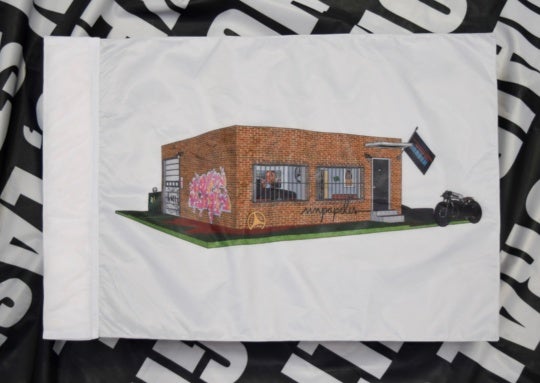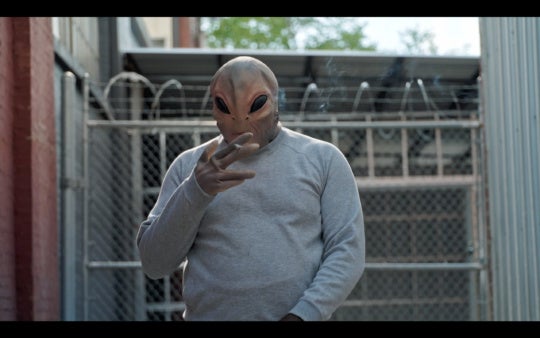The embers of the Civil War barely had time to cool off before Atlanta began styling itself as a phoenix city. By the late 1880s, the Georgia capital was promoting itself as a metropolis rising from the ashes, much like the mythological bird that reanimates itself after death. The city�s enduring image as a place of rejuvenation seems to have attracted the zombie community, as Atlanta has recently become America�s preeminent city of the undead.
If you�re caught in Atlanta�s traffic, or swamped in a local shopping mall, you realize that a zombie horde would seem right at home�the joke practically writes itself. Over the past decade, such local film productions as Zombieland, Dance of the Dead, and The Signal hinted that Atlanta could siphon away the rotting populace of Pittsburgh, hometown of George Romero, director of Night of the Living Dead and Dawn of the Dead.
Atlanta became Zombie City, U.S.A., in 2010 with the start of production on AMC�s The Walking Dead, possibly the highest-profile TV show or film to be shot here in recent years. The Walking Dead commands the highest ratings on basic cable, with the February 10 midseason premiere drawing 12 million viewers (a figure that raises to 16. 6 million for the night if you include that night�s encore broadcast). Among TV�s prized adult demographic, The Walking Dead�s third season currently outdraws such network hits as Modern Family, The Big Bang Theory and NCIS, suggesting that zombies, however exposed in pop culture over the past decade, still have staying power.
The Walking Dead gets many times the ratings of other AMC series, including Mad Men and Breaking Bad, but it doesn�t command the collective consciousness or earn widespread respect the way those cable dramas do. Overall The Walking Dead has received a mixed critical reception, its expansive, apocalyptic vision hindered by draggy storytelling and creative turmoil behind the scenes. Undeniably, The Walking Dead strikes a chord in the culture that both reflects and reshapes the image of Atlanta and the South.
The Walking Dead�s production coincides with the emergence of Georgia as a popular Hollywood shooting destination, but the show comes by its Atlanta location honestly. Writer Robert Kirkman launched The Walking Dead as a comic book series in 2003, coinciding with the beginning of the zombie resurgence marked by 2002�s 28 Days Later, and the 2004 remake of Dawn of the Dead. Like 28 Days Later, The Walking Dead begins with its hero awakening from coma to find his hometown seemingly abandoned, and cannibal ghouls on the loose�a detail Kirkman ascribes to creative coincidence. Although the graphic novel series begins in Kirkman�s home state of Kentucky, it shifts to Atlanta almost immediately.
Kirkman envisioned The Walking Dead as being �like a zombie movie that never ends.� Whereas the typical �living dead� film ends either with all the human heroes being killed or with a handful of survivors riding off into the sunset, Kirkman wanted to explore the implications of the premise over the long term. What would be the challenges, both in terms of sheer survival and the psychological toll, of living in a zombified American landscape? Whereas Max Brooks�s 2006 novel World War Z (an adaptation is due in movie theaters later in 2013) used an oral history-style account to consider the breadth of possibilities of a zombie outbreak, including survivors on submarines and space stations, Kirkman wanted to consider it over time, making The Walking Dead highly suitable for a serialized narrative like comic books or television drama.
On the page and the screen, The Walking Dead subjects its characters to seemingly endless atrocities, not unlike such grisly, old-school horror comics as Tales from the Crypt. Instead of recounting conventional revenge tales in six or eight pages, The Walking Dead has spanned more than 100 issues. Illustrator Charlie Adlard replaced Tony Moore early in the run, but both showed an affinity for rendering mutilations and the corpsey design of the book�s shambling supporting cast. The major visual difference is that The Walking Dead unfolds in stark black and white, while the old EC horror comics favored lurid, overripe colors.
In a similar spirit, the AMC series presents its gore effects with as much disgusting creativity as possible. At times it can be hard to pay attention to The Walking Dead�s human conflicts when you�re witnessing bold new innovations in how to pierce, crush, or lop off a head. Amid the carnage, the show follows a small group of survivors in their struggle to find a safe haven without losing their humanity. From the big city in the first season to a farm in the second to the stronghold communities of the third, The Walking Dead partly explores how to rebuild social structures after the fall of American civilization, exemplified by Atlanta.
The Walking Dead�filmed many of its first season�s six episodes within Atlanta city limits, shooting some scenes near the corner of Forsyth and Marietta streets, at the Sam Nunn Federal Building, and at the Goat Farm Arts Center. The pilot draws some of its most spectacular and horrific images from Kirkman�s first issues (illustrated by Tony Moore and Charlie Adlard), including the gridlock of abandoned cars fleeing the city (filmed on Freedom Parkway). The credits even included the front page of a newspaper called The Atlanta Telegraph. The imagery of highways and rail yards suit Atlanta�s origins a center for transportation�if only the city were still called �Terminus.� Because today�s Atlanta tends to be a city of transplants, it�s appropriate that The Walking Dead�s original group of survivors consisted primarily of Atlanta non-natives, people from surrounding communities who gathered at the outskirts of the city after failing to enter the zombie-choked streets.
The Walking Dead TV series follows a continuity that�s roughly parallel to the graphic novel series, but with significant differences. The show, like most Hollywood treatments of the South, heightens the racial tensions within the group more than the graphic novel series.
Nevertheless, Atlanta also comes across as a place of science and scholarship, with the occasional reference to Georgia Tech. As the home of the Centers for Disease Control, Atlanta commands a place in pop culture like a locus of medical lore, particularly after such superbugs as the Ebola virus became popular subjects for suspense narratives. Steven Soderbergh�s disease disaster film Contagion offered perhaps the most accurate depiction of the center�s generally nondescript offices and labs. In real life, the CDC has shown a sense of humor about zombies, issuing a lighthearted �Zombie Preparedness� blog post in 2011.
The first season�s final episodes took place at the CDC, although the exteriors were shot at the Cobb Energy Performing Arts Center. The interior sets looked less like the real thing and more like one of those abandoned Dharma Initiative bases from Lost, with moody half-lighting and arcane technology. The show�s CDC visit offered a partial explanation for the zombie plague before the place turned into a deathtrap. On the show at least, the CDC�s Atlanta office proves unequal to the challenge of the zombie outbreak, and afterward the cast of survivors abandons cities altogether.
Since ending production on its first season, The Walking Dead films primarily outside Atlanta city limits, with the occasional urban flashback. The city primarily represents itself through its population of extras and supporting actors. The show�s vicious conflicts and existential crises continue to mirror the character of the South as a whole, however�
To be continued…




